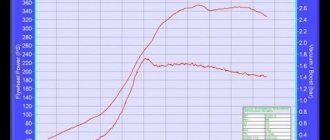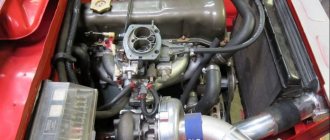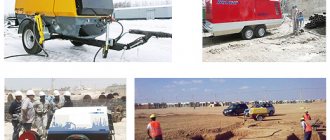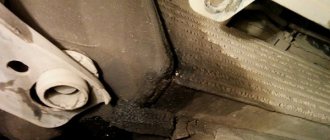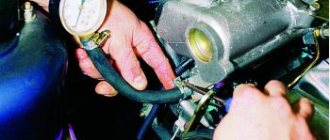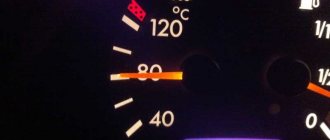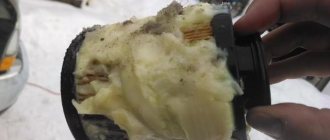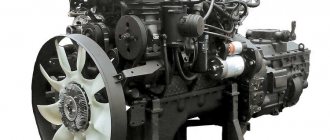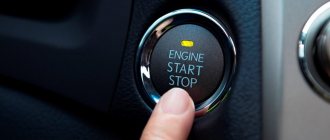- home
- Engine
- …
Often, when we talk about a turbocharged engine, many people remember that with gasoline the turbine life is not so long, approximately 100 - 150,000 km. However, with diesel (also called heavy fuel), the service life of this unit can be at least two (or even three) times longer! Why? Maybe it works there in a special way or a special oil is used? Partly yes, partly no. This question, although not complicated, really requires clarification. As usual there will be a text version + video. So let's read and watch...
For some reason, many are sure that a turbine on a diesel engine and a gasoline engine are very different. BUT this is not true. If we take the classic structure, they will be very similar. Of course, now diesel engines have options with variable geometry and electronic control (after all, progress does not stand still), but if you take the classic layout, everything is the same. Then why is there such a difference in resource, what’s the catch? Don't rush, let's take it in order. First, let's remember how this node works
About the history of the invention and implementation of turbocharging
So, the idea of “putting into action” the energy of exhaust gases appeared soon after the invention and successful experiments in the use of internal combustion engines. German engineers and pioneers of automobile and tractor construction, led by Diesel and Daimler, conducted the first experiments in increasing engine power and reducing fuel consumption by pumping compressed air from exhausts.
Gottdieb Daimler produced cars like this, and was already thinking about introducing a turbocharging system
But the first to build the first efficient turbocharger was not them, but another engineer, Alfred Büchi. In 1911, he received a patent for his invention. The first turbines were such that it was possible and advisable to use them only on large engines (for example, ships).
Next, turbochargers began to be used in the aviation industry. Beginning in the 1930s, the United States regularly launched military aircraft (both fighters and bombers) with gasoline engines equipped with turbochargers. And the first truck in history with a turbocharged diesel engine was made in 1938.
In the 60s, the General Motors Corporation produced the first Chevrolet and Oldsmobile passenger cars with turbocharged gasoline carburetor engines. The reliability of those turbines was poor, and they quickly disappeared from the market.
1962 Oldsmobile Jetfire - the first turbocharged production car
The fashion for turbocharged engines returned at the turn of the 70s/80s, when turbocharging began to be widely used in the creation of sports and racing cars. The “turbo” prefix became extremely popular and turned into a kind of label. In Hollywood films of those years, superheroes pressed the “magic” turbo buttons on the panels of their supercars, and the car sped off into the distance. In reality, the turbochargers of those years noticeably “slowed down,” producing a significant delay in response. And, by the way, not only did they not contribute to fuel economy, but on the contrary, they increased its consumption.
A worker of Soviet fields - the K-701 "Kirovets" tractor with turbocharging
The first truly successful attempts to introduce turbocharging into the production of mass-produced automobile engines were carried out in the early 80s by SAAB and Mercedes. Other global engineering companies were quick to take advantage of this advanced experience.
In the Soviet Union, the development and introduction of turbocharged engines into the “series” was associated, first of all, with the development of the production of heavy industrial and agricultural tractors - “ChTZ”, “Kirovets”; BelAZ super dump trucks, etc. powerful technology.
Why did turbines eventually become widespread on diesel rather than gasoline engines? Because diesel engines have a much higher degree of air compression, and their exhaust gases have a lower temperature. Accordingly, the requirements for the heat resistance of the turbine are much lower, and its cost and efficiency of use are much higher.
Turbo lag and turbo boost
The turbine impeller and compressor wheel are mounted on one common axis. For this reason, a certain dependence is observed, which consists in an increase in the air supply by the compressor only with an increase in turbine speed. Experts distinguish the concept of turbojam (turbolag), which means a delay in the increase in diesel power when the accelerator is sharply pressed.
The turbine impeller is spun by exhaust gases to create effective boost pressure by the turbocharger. Under certain conditions, the turbine can rotate at a very high frequency, which depends on the design features of the device housing and the intensity of the exhaust gas flow.
Self-check of a diesel engine turbocharger. Checking the supercharger without removing it. Presence of oil in the turbine housing, shaft play, impeller.
When and why does it become necessary to adjust the turbocharger actuator. The principle of operation of the device, features and available methods for setting up the wastegate.
What determines the service life of a diesel engine turbocharger? Features and recommendations regarding the operation and repair of turbines with variable geometry.
Turbocharger design, main design elements, turbine selection. Advantages and disadvantages of turbocharged gasoline and diesel engines.
What is a supercharged engine and how does it differ from a naturally aspirated one? The main advantages and disadvantages of turbocharged internal combustion engines. Which motor to choose.
Selecting a mechanical supercharger or turbocharger. Design, main advantages and disadvantages of solutions, installation on an atmospheric tuning engine.
Turbocharging system design
The turbocharging system consists of two parts: a turbine and a turbocharger. The turbine is used to convert the energy of exhaust gases, and the compressor is used directly to supply repeatedly compressed atmospheric air into the working cavities of the cylinders. The main parts of the system are two blade wheels, a turbine and a compressor (the so-called “impellers”). A turbocharger is a high-tech air pump driven by the rotation of a turbine rotor. Its only task is to pump compressed air into the cylinders under pressure.
The more air enters the combustion chamber, the more diesel fuel the diesel engine can burn in a specific unit of time. The result is a significant increase in engine power, without the need to increase the volume of its cylinders.
Components of the turbocharging device:
- compressor housing;
- compressor wheel;
- rotor shaft, or axis;
- turbine housing;
- turbine wheel;
- bearing housing.
The basis of the turbocharging system is a rotor mounted on a special axis and enclosed in a special heat-resistant housing. The continuous contact of all components of the turbine with extremely hot gases determines the need to create both the rotor and the turbine housing from special heat-resistant metal alloys.
The impeller and turbine axis rotate at very high speeds and in opposite directions. This ensures that one element is pressed tightly against another. The flow of exhaust gases first penetrates the exhaust manifold, from where it enters a special channel located in the turbocharger housing. The shape of its body resembles the shell of a snail. After passing through this “snail”, the exhaust gases are accelerated and supplied to the rotor. This ensures forward rotation of the turbine.
The turbocharger axis is mounted on special plain bearings; Lubrication is carried out by supplying oil from the engine compartment lubrication system. O-rings and gaskets prevent oil leaks, as well as air and exhaust gases from blowing through and mixing. Of course, it is not possible to completely eliminate exhaust from entering the compressed atmospheric air, but this is not really necessary...
What it is?
This is a special technical innovation that ensures the forced supply of an additional portion of air into the cylinders. Moreover, this system is relevant not only in relation to automobile internal combustion engines; it is equipped with power units of other vehicles:
- aviation
- diesel locomotives
- ship
Today, this system is not only the most effective way to increase the power of a power unit, but also widespread. Moreover, an increase in the power of turbocharged engines is achieved while maintaining the volume of the cylinders and the number of crankshaft revolutions. Any motor can be equipped with such a system, even if it is not provided for by the design.
How does a diesel engine turbine work?
The power of any engine and its performance depend on a number of reasons. Namely: on the working volume of the cylinders, on the amount of supplied air-fuel mixture, on the efficiency of its combustion, as well as on the energy part of the fuel. Engine power increases in proportion to the increase in the amount of fuel burned in it over a certain unit of time. But to accelerate fuel combustion, it is necessary to increase the supply of compressed air in the working cavities of the engine.
That is, the more fuel is burned per unit of time, the greater the amount of air will need to be “shoved” into the motor (the not very beautiful word “shove” here, however, fits very well, since the motor itself cannot cope with the intake of excess amounts of compressed air , and zero-resistance filters will not help him with this).
This, we repeat, is the main purpose of turbocharging - to increase the supply of air-fuel mixture to the combustion chambers. This is ensured by the injection of compressed air into the cylinders, which occurs under constant pressure. It occurs as a result of converting the energy of exhaust gases, in other words, from waste and lost - into useful. To do this, before the exhaust gases must be discharged into the exhaust pipe, and then into the atmosphere, their flow is directed through the turbocharger system.
This process ensures that the turbine wheel (“impeller”), equipped with special blades, spins up to 100-150 thousand revolutions per minute. The compressor blades, which pump compressed air into the engine cylinders, are also attached to the same shaft with the impeller. The force obtained from converting the energy of the exhaust gases is used to significantly increase air pressure. Thanks to this, it becomes possible to inject a much larger amount of fuel into the working cavities of the cylinders in a fixed time. This gives a significant increase in both power and efficiency of the diesel engine.
Diesel turbine cross-section
Simply put, the turbo system contains two bladed “impellers” mounted on one common shaft. But they are located in separate chambers, hermetically separated from each other. One of the impellers is forced to rotate from the engine exhaust gases constantly flowing onto its blades. Since the second impeller is rigidly connected to it, it also begins to rotate, capturing atmospheric air and supplying it in compressed form to the engine cylinders.
Oil
Well, probably the third reason is diesel engine oil . If you don’t go into the weeds now, the lubricant for the gasoline and diesel versions is different, but not critical. I will say more, they have the same base, but different additives (a diesel engine has more of them and they are slightly different).
When an engine runs on heavy fuel, a lot of sulfur is often formed (these are by-products during combustion). Sulfur is hard crystals that can cause excessive wear on cylinders, shafts, liners, etc. It needs to be removed from the power plant.
That's why these detergent additives exist inside diesel oil. Thus, the turbine is lubricated more efficiently than its opponent.
AND THE REPLACEMENT INTERVAL for a heavy fuel engine should be more frequent. For example, the recommended interval for gasoline is now 15,000 km, and for diesel it is 10,000 km. Lubrication is better and of higher quality, which has a positive effect on all components and assemblies.
Now we are watching the video version.
This is where I end, I think my materials were useful to you, SINCERELY YOUR AUTOBLOGGER
Similar news
- The main reasons for high engine oil consumption. Why is he...
- Timing belt resource. We will analyze foreign cars, as well as PRIORA, KALINA and GR...
- How do hydraulic compensators affect engine power? Details +...
Add a comment Cancel reply
Necessary additions to the turbocharging system: valves, intercooler
It took engineers decades to create a truly efficient turbocharger. After all, it’s only in theory that everything looks smooth: by converting the energy of exhaust gases, you can “recover” the lost percentage of efficiency and significantly increase engine power (for example, from one hundred to one hundred and sixty horsepower). But for some reason this did not work out in practice.
In addition, when you pressed the accelerator sharply, you had to wait for the engine speed to increase. It happened only after a certain pause. The increase in exhaust gas pressure, the spin-up of the turbine and the injection of compressed air did not occur immediately, but gradually. This phenomenon, called “turbolag” (“turbo lag”), could not be tamed. And it was possible to cope with it by using two additional valves: one to bypass excess air into the compressor through a pipeline from the engine manifold. And the other valve is for exhaust gases. And in general, modern turbines with variable blade geometry, even in their shape, are already significantly different from the classical turbines of the second half of the twentieth century.
Bosch diesel turbocharger
Another problem that had to be addressed during the development of diesel turbine technology was excessive detonation. This detonation occurred due to a sharp increase in temperature in the working cavities of the cylinders when additional masses of compressed air were pumped into them, especially at the final stage of the stroke. The charge air intercooler (intercooler) is designed to solve this problem in the system.
An intercooler is nothing more than a radiator for cooling the charge air. In addition to reducing detonation, it also reduces the air temperature in order not to reduce its density. And this is inevitable during the heating process from compression, and from this the efficiency of the entire system drops significantly.
In addition, a modern engine turbocharging system cannot do without:
- control valve (wastegate). It serves to maintain optimal pressure in the system, and to release it, if necessary, into the exhaust pipe;
- bypass valve. Its purpose is to divert charge air back into the intake pipes up to the turbine, if it is necessary to reduce power and the throttle valve closes;
- and/or “blow-off-valve”. Which bleeds charge air into the atmosphere if the throttle is closed and there is no mass air flow sensor;
- exhaust manifold compatible with turbocharger;
- sealed pipes: air pipes for supplying air to the intake, and oil pipes for cooling and lubrication of the turbocharger.
Schematic diagram
To understand how a turbine works, you should familiarize yourself with the operating procedure of the internal combustion engine.
As a rule, most engines are four-stroke piston engines; their operation is always controlled by the valves of the intake and exhaust groups. One cycle of work is four strokes, which take place in two full revolutions of the crankshaft. The principle of operation of a turbine on a diesel engine is quite simple and consists of the following actions:
- intake - the piston goes down, allowing air to penetrate through the intake valve;
- compression - at this moment the combustible mixture is compressed;
- expansion process - fuel enters under pressure and ignites;
- release - the piston goes up, releasing gas.
Application of turbocharging in global mechanical engineering
It’s the twenty-first century, and no one is anymore chasing the name of their car with the “turbo” prefix, which was fashionable in the 20th century. Nobody believes in the “magical power of a turbine” to dramatically accelerate a car anymore. The meaning of the use and efficiency of the turbocharging system is still not the point.
This is a “snail”!
Of course, turbocharging is most effective when used on tractor and heavy truck engines. It allows you to add power and torque without excessive fuel consumption, which is very important for the economic performance of the equipment. That's where it is used. Turbo systems have also found wide application on diesel locomotive and marine diesel engines. And these are the most powerful man-made turbines for a diesel engine.
Turbocharged engine: operating rules
In order for a diesel turbine to operate with maximum efficiency and not fail for as long as possible, you need to adhere to certain rules during the operation of the car:
- adhere to the oil change schedule, which will prevent clogging of the oil line with abrasives;
- use high-quality motor oil that meets the specifications in the engine data sheet;
- do not start immediately after turning on the engine - the engine must be warmed up;
- immediately after stopping movement, do not turn off the engine, allowing it to idle for at least 10 seconds.
Main malfunctions - signs and causes
It’s worth mentioning right away that the main cause of breakdowns is untimely maintenance of the unit; it is recommended to carry it out at least once a year. The next reason is low quality oil or untimely replacement.
The third is the entry of foreign objects into the device (for example, small pebbles). Finally, the fourth is the banal wear and tear of individual turbine components, because each equipment has its own service life. Now we will describe the signs that may indicate a malfunction.
Black smoke from the exhaust pipe. The fuel burns in the intercooler or charge line. Most likely there is a malfunction of the control system.
Blue smoke. Perhaps due to a failure in the turbine seal, oil leaks into the combustion chamber.
White smoke. The oil drain line is dirty and will need to be cleaned.
Increased fuel consumption. Air does not reach the compressor.
Increased oil consumption. It is necessary to check the joints of the pipes - the tightness may be broken.
Reduced acceleration dynamics. Most likely, the control system failed, causing a lack of oxygen.
Extraneous whistling, grinding or noise. This could be a change in the rotor clearance, a defect in the housing, an air leak between the engine and the turbine, or contamination of the oil line.
You should always follow the operating rules of the unit - this will reduce the likelihood of breakdowns and extend the life of the device. You should follow a few simple rules:
- monitor the quality of fuel and oil;
- do not forget to change the oil and filters on time;
- start driving only after the engine has warmed up;
- After stopping movement, you need to let the engine idle, and not immediately turn it off.
And, of course, you should undergo regular maintenance.
